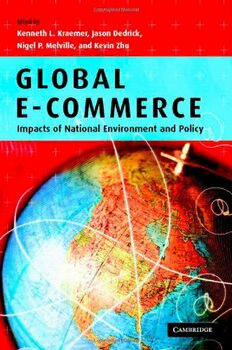
Global e-commerce: Impacts of National Environment and Policy PDF
Preview Global e-commerce: Impacts of National Environment and Policy
Global e-Commerce Are the Internet and e-commerce truly revolutionizing business practice? This book explodes the transformation myth by demonstrating that the Internet and e-commerce are in fact being adapted by firms to reinforce their existing relationships with customers, suppliers, and business part- ners.Detailedcasestudiesofeightcountriesshowthat,ratherthancreating a borderless global economy, e-commerce strongly reflects existing local patternsofcommerce,business,andconsumerpreference,anditsimpact therefore varies greatly by country. Paradoxically, while e-commerce is increasing the efficiency, effectiveness, and competitiveness of firms, it is alsoincreasingthecomplexityoftheirenvironmentsastheyhavetodeal withmorebusinesspartnersandalsofacegreatercompetitionfromother firms.Thisincisiveanalysisofthediffusionandimpactofe-businesspro- videsacademicresearchers,graduates,andMBAstudentswithasolidbasis forunderstandingitslikelyevolution. Kenneth L. Kraemer isProfessoratthePaulMerageSchoolofBusi- ness and at the Donald Bren School of Information and Computer Sci- ence, University of California, Irvine. He is also Director of the Center forResearchonInformationTechnologyandOrganizations(CRITO)and DirectorofthePersonalComputingIndustryCenter(PCIC). Jason Dedrick is Co-Director of the Personal Computing Industry Center and Senior Research Fellow at CRITO, University of California, Irvine. Nigel P. Melville is Assistant Professor of Business Information Technology at the Stephen M. Ross School of Business, University of Michigan. Kevin Zhu isAssociateProfessorattheRadySchoolofManagement, UniversityofCalifornia,SanDiego. Global e-Commerce Impacts of National Environment and Policy Editedby kenneth l. kraemer jason dedrick nigel p. melville kevin zhu Cambridge, New York, Melbourne, Madrid, Cape Town, Singapore, São Paulo Cambridge University Press TheEdinburghBuilding,Cambridge,UK Published in the United States of America by Cambridge University Press, New York www.cambridge.org Information on this title: www.cambridge.org/9780521848220 © Cambridge University Press 2006 Thispublicationisincopyright.Subjecttostatutoryexceptionandtotheprovisionof relevant collective licensing agreements, no reproduction of any part may take place without the written permission of Cambridge University Press. Firstpublishedinprintformat 2006 - ---- eBook (NetLibrary) - --- eBook (NetLibrary) - ---- hardback - --- hardback Cambridge University Press has no responsibility for the persistence or accuracy of s forexternalorthird-partyinternetwebsitesreferredtointhispublication,anddoesnot guaranteethatanycontentonsuchwebsitesis,orwillremain,accurateorappropriate. Contents List of figures page vii List of tables ix List of boxes xiv Notes on contributors xv Introduction 1 KennethL.Kraemer,JasonDedrick,and NigelP.Melville 1 Globalizationandnationaldiversity:e-commerce diffusion and impacts across nations 13 KennethL.Kraemer,JasonDedrick,and NigelP.Melville 2 TheUnitedStates:adaptiveintegrationversustheSilicon Valley model 62 JasonDedrick,KennethL.Kraemer,JohnL.King,and KalleLyytinen 3 France: an alternative path to Internet-based e-commerce 108 EricBrousseauandBrunoChaves 4 Germany:a“fastfollower”ofe-commercetechnologies and practices 141 WolfgangKoenig,RolfT.Wigand,andRomanBeck 5 Japan: local innovation and diversity in e-commerce 173 DennisS.Tachiki,SatoshiHamaya,andKouYukawa 6 China: overcoming institutional barriers to e-commerce 209 Zixiang(Alex)TanandOuyangWu v vi Contents 7 Taiwan:diffusionandimpactsoftheInternetand e-commerce in a hybrid economy 247 Tain-JyChen 8 Brazil: e-commerce shaped by local forces 278 PauloBastosTigre 9 Mexico:globalengagementdrivinge-commerceadoption and impacts 306 JuanJ.Palacios 10 Globalconvergenceandlocaldivergenceine-commerce: cross-country analyses 345 KevinZhu,SeanXu,KennethL.Kraemer, andJasonDedrick APPENDICES I – Data collection and survey instrument 385 II – GEC Survey measures by sector and size 404 III – GEC Survey measures by country 413 Index 429 Figures 1.1 Conceptualframework page16 1.2 Degreeofglobalizationoffirmsineacheconomy 23 1.3 E-commercediffusionandwealth 24 1.4 Internet-basede-commercediffusion,1998–2003 34 1.5 Firmusesofe-commerce 36 1.6 Useofe-commercebyhighglobalandhighlocal firms 38 1.7 E-commerceusesacrosseconomies 40 1.8 B2BandB2Ce-commerceinhighlocalandhigh globalfirms 43 1.9 FirmsengagedinB2BandB2Cbyeconomy 45 1.10 Firmimpactsfrome-commerce 48 1.11 Performanceimpactdifferencesbetweenhighglobal andhighlocalfirms 49 1.12 Impactonvaluechainandcompetition 50 2.1 Useofe-commercetechnologies:USandglobalfirms 75 2.2 EnterpriseintegrationinUSfirms,2002 78 2.3 DriversforInternetusefore-commerce,2002 80 2.4 BarrierstoInternetusefore-commerce(percent indicatingbarrierisasignificantobstacle) 83 2.5 ImpactsfromuseoftheInternetfore-commerce 98 4.1 Useofe-commercetechnologies 150 4.2 E-commercedrivers 154 4.3 E-commercebarriers 157 4.4 Internet-basede-businessdiffusion,1998–2003 159 4.5 UseoftheInternet 161 5.1 Analyticalframework 177 5.2 E-commercereadiness–enterpriseintegration 187 5.3 E-commercedriversforInternetuse 189 5.4 E-commercebarrierstoInternetuse 192 5.5 E-commerceadoption–typesofuse 201 vii viii Listoffigures 6.1 Useofe-commercetechnologies 223 6.2 Integrationmode 226 6.3 E-commercedrivers 229 6.4 E-commercebarriers 232 6.5 E-commercediffusion 236 7.1 Useofe-commercetechnologies 255 7.2 Integrationmode 258 7.3 E-commercedrivers 260 7.4 E-commercebarriers 262 7.5 E-commercediffusion 266 8.1 Useofe-commercetechnologies 286 8.2 E-commercereadiness–enterpriseintegration 288 8.3 E-commercedriversofInternetuse 290 8.4 BarrierstoInternetusefore-commerce 293 8.5 E-commerceadoption–typesofuse 295 9.1 Integrationmode 318 9.2 Driversofe-commercediffusion 323 9.3 Barrierstoe-commercediffusion 326 9.4 Internetpenetrationbyfirmsize 328 9.5 UseoftheInternet 330 10.1 Conceptualmodel 348 10.2 Developedvs.developingeconomies 357 10.3 Researchofe-commercediffusion 358 10.4 ResearchstreamI:e-commerceadoption 362 10.5 ResearchstreamII:frome-commerceadoption touse 366 10.6 ResearchstreamIII:frome-commerceusetoimpacts 370 Tables 1.1 Conceptualframework page18 1.2 GECSurveysample 20 1.3 Macroeconomicindicators,2002 26 1.4 Technologyindicators,2002 28 1.5 Firmdriverstoe-commerceuse 31 1.6 Firmbarrierstoe-commerceuse 31 1.7 B2BandB2Csalesandservices 41 2.1 Macroeconomicindicators,1998–2002 67 2.2 InternationalizationofUSfirms 68 2.3 Technologyinfrastructure,1998–2002 69 2.4 Informationinfrastructure,1995–2002 72 2.5 Useofe-commercetechnologiesinUSfirms,2002 74 2.6 InvestmentinITbyUSfirms,2002 76 2.7 Enterpriseintegrationstrategy,2002 77 2.8 Driversofe-commerce 79 2.9 Barrierstoe-commerce 82 2.10 USshipmentsande-commerce,2002(billionsof dollars) 84 2.11 ToptwentyUSInternetretailers,2000 86 2.12 UsesoftheInternet,2002 89 2.13 Firmonlinesalesandprocurement 90 2.14 Onlineservices,2002 91 2.15 HowfirmsusetheInternettosellproductsand services 92 2.16 ParticipationinanInternet-basedtrading community,2002 93 2.17 Impactsofdoingbusinessonline,2002 96 2.18 Associationbetweenexternalintegrationandcosts 97 2.19 Changesinfirms’environmentsinceusingthe Internet 100 ix
